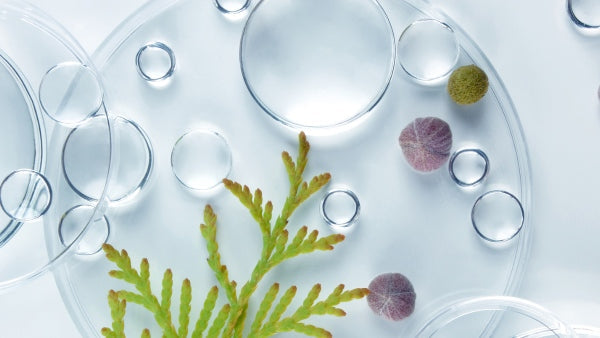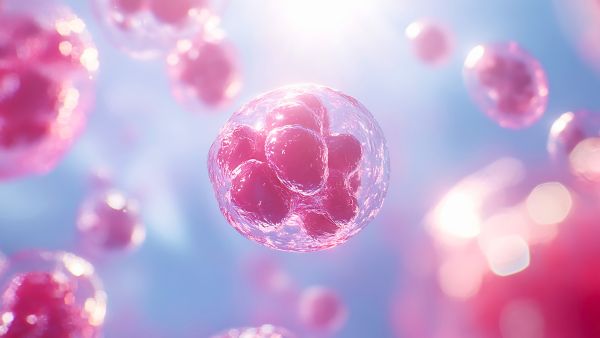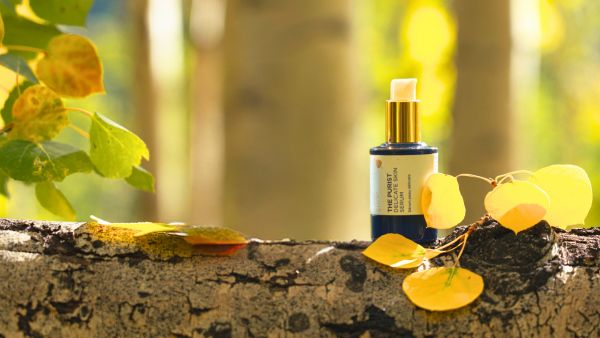Hyaluronic Acid: Size Matters

Hyaluronic acid is a naturally occurring substance in our bodies. In skincare, it's prized for its ability to hold up to 1,000 times its weight in water, giving skin a soft, plump texture and a more even tone. It can also improve the appearance of fine lines and wrinkles and is generally gentle on the skin barrier.
However, not all hyaluronic acid molecules are created equal. There are different sizes, and these variations significantly impact how the ingredient interacts with your skin. Hyaluronic acid is often listed on ingredient labels as sodium hyaluronate (INCI = Sodium Hyaluronate), which doesn't specify the molecular size. Therefore, understanding the difference between these sizes is crucial for achieving your desired results.
Think of hyaluronic acid as a big drink of water for your skin. But the way that water is delivered depends on the size of the molecules. We can broadly categorize them by molecular weight: low and high.
High Molecular Weight Hyaluronic Acid
High molecular weight hyaluronic acid molecules are larger and cannot penetrate the skin barrier. Instead, they form a film on the skin's surface, binding with keratin upon evaporation. This film provides surface hydration, improves elasticity, and has anti-inflammatory and soothing properties. However, because it sits on the surface, this film is easily washed away, offering only short-term benefits.
- Pros: Surface hydration, improved elasticity, anti-inflammatory, soothing.
- Cons: Short-term effects, easily washed away, no deep penetration.
Low Molecular Weight Hyaluronic Acid
Low molecular weight hyaluronic acid molecules are smaller and can penetrate deeper into the skin, reaching the connective tissue. Here, they bind water to skin cells, infusing all layers of the skin with moisture. This deeper hydration contributes to firmer, more supple skin and can visibly reduce wrinkles. The key advantage is that the moisture is stored more sustainably within the skin, providing longer-lasting effects. However, it's important that low molecular weight HA is used in proper ratios, as improper concentrations can potentially irritate the skin.
- Pros: Deep hydration, improved firmness and elasticity, visible wrinkle reduction, longer-lasting effects.
- Cons: Potential for irritation if used in improper concentrations.

Myths About Hyaluronic Acid: What Most People Get Wrong
Hyaluronic acid is often considered a “miracle ingredient” in skincare, and while it truly offers impressive benefits, there are several misconceptions surrounding its use. These misunderstandings can lead to suboptimal results or even frustration with products that contain HA. Here’s what you need to know to ensure you’re using HA effectively and seeing the results you deserve.
1. All hyaluronic acid is the same
One of the biggest misconceptions is that all hyaluronic acid is created equal, but in truth, its molecular size determines how it works and what it can do for your skin. Many products simply list "sodium hyaluronate" or "hyaluronic acid" on their ingredient label, leaving customers in the dark about the molecular weight of the HA being used.
-
Why This Matters:
High molecular weight HA sits on the surface of your skin, forming a temporary hydrating film that feels silky but lacks deeper, long-term impact. In contrast, low molecular weight HA penetrates into the deeper layers of the skin, replenishing hydration where it’s needed most and supporting long-lasting moisture retention.
However, many brands avoid specifying molecular weights in their marketing materials because high molecular weight HA provides an immediate plumping effect, which can be visually convincing in the short term but doesn’t support skin health over time. -
Takeaway for You:
If your goal is to achieve long-term hydration, elasticity, and improved skin texture, look for products like Telluride Glow's Aspen Dew Illuminating Essence, that use low molecular weight HA in proper concentrations to sustain moisture levels beneath the surface.
2. More hyaluronic acid = better results
Another common myth is that products with higher concentrations of hyaluronic acid will deliver better results. While this might seem logical, it’s not how HA works.
-
The Science Behind It:
Hyaluronic acid has the unique ability to bind up to 1,000 times its weight in water, but it doesn’t act as a self-contained moisturizer. Instead, it draws moisture from its surrounding environment—either from the air or, in dry conditions, from the deeper layers of your skin. When used in overly high concentrations or without proper occlusion (a sealing layer like a serum or oil), HA can actually dehydrate the skin by pulling moisture out and allowing it to evaporate.
Additionally, HA that is too concentrated can sometimes disrupt the skin’s barrier, leading to irritation, especially for individuals with sensitive or compromised skin. -
Takeaway for You:
Rather than seeking the highest concentration of HA, focus on formulations where HA is balanced with complementary ingredients and designed to work in harmony with your skin’s natural processes. Proper formulation matters more than percentage claims on a label.
3. Hyaluronic acid works alone
Many people believe that hyaluronic acid is a one-stop solution for hydration, but this is another oversimplification. While HA is excellent at attracting water, it doesn’t necessarily lock that water into the skin on its own.
-
The Science Behind It:
Without a sealing layer, the moisture HA attracts to your skin can quickly evaporate, leaving your skin feeling drier than before. This process is called transepidermal water loss (TEWL). In fact, HA needs to be layered with occlusive or emollient ingredients—like oils or rich serums—to create a protective barrier that prevents moisture from escaping.
Think of HA as the water your skin needs, while occlusives are the lid on the container that keeps that water from evaporating. This combination ensures your skin stays plump, hydrated, and radiant throughout the day. -
Takeaway for You:
For best results, follow your HA application with an occlusive product, like Telluride Glow’s Alpine Phytonutrient Serum or The Purist Delicate Skin Serum, to lock in the moisture and amplify the benefits of hyaluronic acid. This two-step hydration strategy is especially important in dry climates or during colder months when environmental factors can exacerbate dehydration.
4. Hyaluronic acid is universally gentle
While hyaluronic acid is often praised as a safe, non-irritating ingredient suitable for all skin types, even this claim has its caveats. Though rare, HA can cause irritation or dryness when used improperly.
-
The Science Behind It:
Low molecular weight HA, in particular, is known to penetrate deeper into the skin. While this is beneficial for hydration, it can occasionally irritate individuals with highly sensitive or reactive skin if used in excessive concentrations or without balancing ingredients. High molecular weight HA, on the other hand, is less likely to cause irritation because it remains on the surface.
Another source of irritation can come from how HA is formulated. If the product includes unnecessary fillers, synthetic fragrances, or drying alcohols alongside the HA, these can counteract its hydrating effects and irritate the skin barrier. -
Takeaway for You:
Always check not just for the type of HA used, but also for the overall formulation. Products like Telluride Glow’s Aspen Dew Illuminating Essence are specifically designed with low molecular weight HA in carefully calibrated concentrations to deliver results without compromising the skin’s health. And, as always, follow up with a moisture-sealing layer to reduce any chance of irritation.
5. Hyaluronic acid can replace moisturizer
One of the most persistent myths is that using a hyaluronic acid serum eliminates the need for a moisturizer. This misunderstanding can lead to underwhelming results for customers who stop moisturizing altogether after introducing HA into their routine.
-
The Science Behind It:
HA is a humectant, meaning it attracts water to itself. However, it doesn’t add fats or oils to the skin, which are necessary for supporting the lipid barrier and preventing water from escaping. Skipping a moisturizer, especially in colder or drier climates, can leave your skin vulnerable to dehydration despite using HA.
Additionally, hyaluronic acid works synergistically with moisturizers and emollients, meaning the combined effect is greater than either product alone. -
Takeaway for You:
Think of HA as the hydration hero, and your moisturizer or serum as the partner that helps lock in that hydration for the long haul. To maximize results, follow your HA with an occlusive layer, such as Telluride Glow’s Alpine Phytonutrient Serum, which not only seals in moisture but also adds nutrient-rich oils to nourish your skin.
6. Hyaluronic acid always comes from natural sources
Finally, it’s important to note that while HA is naturally present in the human body, not all HA used in skincare products is sourced naturally. In fact, much of the HA on the market today is synthetically derived or produced via bacterial fermentation.
-
Why This Matters:
While synthetic HA is effective, it’s important to choose formulations that prioritize purity and safety, particularly if you have sensitive skin or are concerned about environmental sustainability. Some formulations may include synthetic additives or stabilizers that compromise the integrity of the product. -
Takeaway for You:
When choosing an HA product, consider brands like Telluride Glow that are transparent about their ingredient sourcing and formulations. Knowing how and where your HA is sourced can ensure you’re getting the safest, most effective hydration for your skin.

Our formulas
At Telluride Glow, our first priority is to formulate effective and safe products. We use a low molecular weight in our Aspen Dew Illuminating Essence to give you lasting results, with proper ratios to ensure a non-irritating formula. Some brands typically use a combination of high molecular weight as it shows immediate effects to convince the buyer of its effectiveness. However, the effectiveness isn’t long lasting if your goal is to support your skin in the long run.
Best way to apply a hyaluronic acid serum
Though hyaluronic acid can attract and retain moisture, it doesn’t necessarily keep that moisture from evaporating over time. That’s why it’s important to maximize the benefits by adding occlusive products after the essence, like our Alpine Phytonutrient Serum or The Purist Delicate Skin Serum. These serums seal in the moisture drawn into skin by the hyaluronic acid, and the two work together to ensure skin is both hydrated and stays that way.
Fun fact
Tremella mushroom Tremella fuciformis, is a key ingredient in our Snow Rose Recovery Mask for water retention. Tremella's particle sizes are actually smaller than those of HA, giving Tremella the ability to hold 5 times more water than hyaluronic acid!
Hyaluronic acid is a powerful tool in your skincare arsenal, but it’s not a magic bullet.
By understanding how molecular weight affects its function, how to properly layer it with other products, and why thoughtful formulations matter, you can make informed decisions that deliver real results.
Telluride Glow’s HA-based products are crafted with transparency, effectiveness, and long-term skin health in mind—because we believe in giving your skin the hydration it deserves, backed by science and nature.



